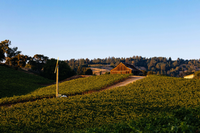 Hawk Pinot Noirs and was pleased to see their subtle evolution.
Hawk Pinot Noirs and was pleased to see their subtle evolution.
Maggy Hawk is a wine estate owned by Barbara Banke, who heads the Jackson Family Estate collection of wineries in six countries. The estate is situated in the western part of Anderson Valley, where it is one of the vineyards closest to the Pacific Ocean, at the cool end of a cool region. The property is a patchwork of slopes deliberately planted with different vine orientations and different clones. Five vineyard blocks exist, but the 2017 wines represent only four of them. The estate takes its name from one of Banke’s favorite race horses, and each of the 2017 Pinot Noir wines carries the name of one of Maggy Hawk’s offspring.
Like the 2012’s, these four 2017 Pinot Noirs share an intensity of aroma, soft and silky texture and general charm. In the 2017’s, however, I notice more freshness, more vibrancy in most of them, less evidence of oak, more nuance and modulated alcohol levels.
Although the four wines were easy to enjoy when I first poured them, they improved overnight to reveal depth and nuance that was not apparent at first. My preferences shifted. The 2017 Jolie, for example, was among my least favorites at first, until its fresh acidity and delicacy revealed themselves. Ultimately, I judge it to be a real beauty, with aromas and flavors of red fruits — raspberry, red cherry, strawberry — floral notes and tea, and a vibrant structure of acid and tannin that is not overpowered by the aromatics. The wine has depth, as well as purity and concentration of fruit expression.
The 2017 Unforgettable is an enigmatic Pinot Noir because it is a big wine and yet it shows elements of freshness and light. Its aromas and flavors are in the ripe black-fruits realm, with cocoa and floral notes. Tannin is noticeable in the wine’s structure, but the fruit balances the tannin, and the tannin balances the alcohol. The pieces come together into a rich, ripe, flavorful Pinot Noir that expresses power without overwhelming you. This wine derives from two blocks and two very different clones — 777 and 2A — vinified separately, which accounts for its duality of expression.
The 2017 Stormin’ Pinot Noir for me took an early lead out of the gate because I could immediately perceive its depth, freshness and acidity. My opinion of this wine diverges from the winemaker’s notes, which describe it as “rich and assertive” and “dark and brooding.” I perceive the richness, but find freshness of red fruit expression, precision and vibrancy within that richness. I do agree that this wine has a “muscular frame,” but my palate experiences the elements of freshness and vibrancy rather than the weight.
Looking to establish a quality hierarchy among the four wines as I tasted them, I quickly decided that the 2017 Afleet was my least favorite, because I found it to be big, blunt and beefy — not my preferred style of Pinot Noir. But: it’s fascinating! Perfectly ripe, with aromatics of both black and red fruit, earth, dried herbs, licorice and even blood oranges, it’s creamy-textured, full, and dramatic, with noticeable tannin, and yet glints of freshness and light within. This wine was made using 25 to 30 percent whole cluster fruit, which probably accounts for its freshness of flavor. It’s still on the big side for my taste, but an admirable Pinot Noir.
These four wines share the same suggested retail price, $65. My scores are so tightly clustered that individual scores become meaningless. All four wines are in the 91-92 range, with Jolie the highest of the four, at 93 Points.
Read more by Mary Ewing-Mulligan: "On My Table"
